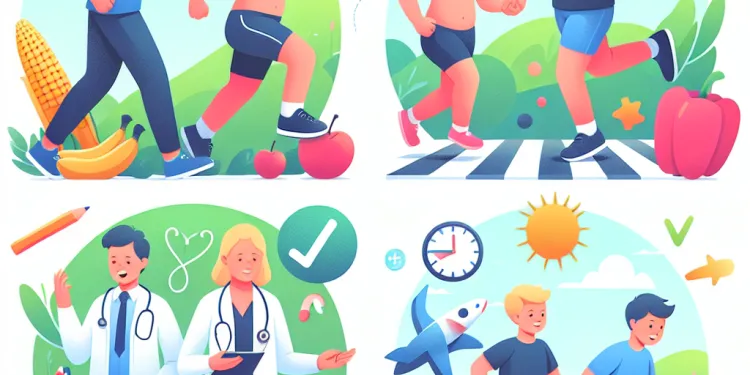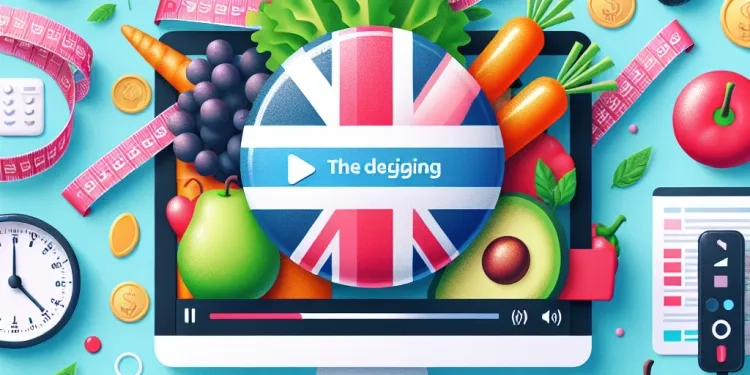
Find Help
More Items From Ergsy search
-

What are the current statistics on childhood obesity in the UK?
Relevance: 100%
-

Is childhood obesity a concern in the United Kingdom?
Relevance: 81%
-

Is childhood obesity a concern in the United Kingdom?
Relevance: 74%
-

Study Finds Alarming Increase in Childhood Obesity Rates Post-Pandemic
Relevance: 57%
-

Is obesity more prevalent in certain regions of the UK?
Relevance: 47%
-

Obesity
Relevance: 44%
-

Can genetics influence obesity?
Relevance: 38%
-

What health risks are associated with obesity?
Relevance: 37%
-

Childhood squint | NHS
Relevance: 36%
-

What causes obesity?
Relevance: 35%
-

Are there any societal factors that contribute to obesity?
Relevance: 34%
-

How is obesity measured?
Relevance: 34%
-

How can obesity be prevented?
Relevance: 33%
-

What treatments are available for obesity?
Relevance: 33%
-

What is the impact of obesity on mental health?
Relevance: 32%
-

Childhood dyspraxia: James' story | NHS
Relevance: 31%
-

The effective treatment of childhood constipation according to NICE guidelines.
Relevance: 30%
-

What role do sugary drinks play in obesity?
Relevance: 30%
-

How important is physical activity in preventing obesity?
Relevance: 29%
-

Dealing with Common Childhood Illnesses
Relevance: 29%
-

What role does diet play in managing obesity?
Relevance: 29%
-

What impact has the sugar tax had on obesity rates?
Relevance: 28%
-

Rise in Childhood Asthma Linked to Air Pollution in Urban Areas
Relevance: 25%
-

Has the sugar tax affected the sugar content in drinks?
Relevance: 18%
-

What causes asthma?
Relevance: 17%
-

Can Wegovy be used by children?
Relevance: 16%
-

What condition does Wegovy treat?
Relevance: 14%
-

What sources should I consult for information on Covid-19?
Relevance: 12%
-

How prevalent is autism?
Relevance: 12%
-

Prader-Willi Syndrome | NHS
Relevance: 12%
-

Is asthma more common in certain age groups?
Relevance: 12%
-

What kind of studies are conducted to investigate links between medications and autism?
Relevance: 12%
-

Can chickenpox be prevented?
Relevance: 12%
-

Is driving without a seatbelt considered dangerous driving?
Relevance: 11%
-

How is the revenue from the sugar tax used?
Relevance: 11%
-

What are the long-term goals of the sugar tax?
Relevance: 11%
-

What are risk factors for developing sleep apnea?
Relevance: 11%
-

Who pays the sugar tax?
Relevance: 11%
-

How does GLP-1 affect appetite?
Relevance: 11%
-

What causes Type 2 Diabetes?
Relevance: 11%
Current Statistics on Childhood Obesity in the UK
Introduction
Childhood obesity is a significant public health concern in the United Kingdom, with trends showing an increasing prevalence over recent years. This condition not only affects the health of children but also poses long-term risks leading into adulthood. Understanding the current statistics on childhood obesity is crucial for implementing effective interventions and policies.Prevalence Rates
As of the latest reports, about 1 in 10 children in the Reception year (aged 4 to 5 years) are classified as obese in the UK. This figure rises as children grow older, with approximately 1 in 5 children in Year 6 (aged 10 to 11 years) considered obese. This worrying trend indicates that obesity is more prevalent among older children.Socioeconomic Disparities
There is a stark correlation between childhood obesity rates and socioeconomic factors. Children living in deprived areas show significantly higher obesity rates compared to those in more affluent regions. Data suggests that children in the most deprived parts of England are approximately twice as likely to be obese as those in the least deprived areas. Addressing these disparities is essential for reducing overall obesity levels.Gender and Ethnic Variations
Statistics indicate that obesity rates can vary by gender and ethnicity. Boys in the UK are slightly more likely to be obese than girls at both Reception and Year 6 stages. Additionally, children from certain ethnic minority groups, such as Black and South Asian communities, show higher obesity rates compared to their White counterparts.Health and Economic Impacts
Childhood obesity leads to numerous health issues, including an increased risk of developing type 2 diabetes, cardiovascular diseases, and mental health problems. The economic implications are significant as well, with considerable costs associated with healthcare and loss of productivity. Efforts to mitigate obesity can lead to substantial health and economic benefits for the UK.Conclusion
The current statistics on childhood obesity in the UK highlight a growing health challenge that requires urgent action. By understanding the demographic and socioeconomic factors involved, more targeted strategies can be developed to combat obesity. Collaborative efforts among governments, healthcare providers, and communities are necessary to reverse these troubling trends.Child Obesity Numbers in the UK
What Is Child Obesity?
Child obesity means that many kids in the UK are heavier than they should be for their age and height. This can make them unhealthy now and as they grow up. Knowing how many kids have this problem helps us make plans to help them.How Many Kids Are Obese?
Right now, about 1 in 10 kids who are 4 or 5 years old are too heavy. As kids get older, the number goes up. By age 10 to 11, about 1 in 5 kids are too heavy. This means many older kids are affected.Rich and Poor Areas
Kids living in poorer areas are more likely to be too heavy compared to kids living in richer areas. In the poorest places, kids are twice as likely to be too heavy as those in the richest places. It's important to help kids in all areas.Boys, Girls, and Different Backgrounds
More boys than girls are too heavy when they are 4 to 5 and 10 to 11 years old. Kids from Black and South Asian backgrounds are also more likely to be too heavy than kids from White backgrounds.Why Is This a Problem?
Being too heavy can make kids sick, with problems like diabetes, heart disease, and feeling sad. It also costs a lot of money to take care of them when they are sick. Helping kids stay healthy is good for them and saves money.What Can We Do?
The numbers show we need to act fast to help kids. By learning who needs help and why, we can make better plans. Everyone needs to work together – schools, families, and doctors – to help kids be healthier.Frequently Asked Questions
What is the current prevalence rate of childhood obesity in the UK?
As of the latest data, approximately one in five children aged 10 to 11 in the UK is obese.
How has childhood obesity in the UK changed over recent years?
Childhood obesity rates in the UK have shown a rising trend over the past few decades, though recent years have seen some stabilization.
Are there specific age groups where childhood obesity is more prevalent in the UK?
Childhood obesity is particularly prevalent among children aged 10 to 11, with notable increases observed as children age from early to late childhood.
What are the gender differences in childhood obesity rates in the UK?
Boys generally have slightly higher obesity rates compared to girls in the UK, though the difference is not very large.
How does socioeconomic status affect childhood obesity rates in the UK?
Children from lower socioeconomic backgrounds in the UK are more likely to be obese compared to those from higher socioeconomic backgrounds.
Is childhood obesity common across all regions in the UK?
Childhood obesity rates vary across regions, with some areas experiencing higher rates than others, often correlating with socioeconomic factors.
What role does ethnicity play in childhood obesity rates in the UK?
There are disparities in childhood obesity rates among different ethnic groups in the UK, with some groups experiencing higher rates than others.
What impact has COVID-19 had on childhood obesity rates in the UK?
The COVID-19 pandemic likely contributed to an increase in childhood obesity rates in the UK due to changes in physical activity and eating habits.
What percentage of children aged 4 to 5 are obese in the UK?
Approximately 10% of children aged 4 to 5 in the UK are classified as obese.
What are the UK government’s goals regarding childhood obesity?
The UK government aims to halve childhood obesity levels by 2030 through various public health initiatives.
How does the childhood obesity rate in the UK compare to other countries?
The UK has one of the higher rates of childhood obesity in Europe, similar to countries like the United States.
What measures are schools in the UK taking to combat childhood obesity?
Schools in the UK are implementing programs to promote healthy eating, increase physical activity, and educate children about healthy lifestyles.
What role does advertising play in childhood obesity in the UK?
Advertising of unhealthy foods and drinks, particularly to children, is considered a factor contributing to childhood obesity in the UK.
Have there been any recent changes in policy to address childhood obesity in the UK?
The UK government has introduced initiatives like the soft drinks industry levy and public health campaigns to address childhood obesity.
How can parents help reduce the risk of obesity in their children?
Parents can encourage a balanced diet, regular physical activity, limit screen time, and foster healthy eating habits to reduce the risk of obesity in their children.
How many children are overweight in the UK right now?
Tip: You can use pictures or charts to help understand numbers better.
Right now, about 1 out of every 5 kids who are 10 or 11 years old in the UK are very overweight.
How has the number of children who are very overweight in the UK changed lately?
Let's talk about how many children in the UK are very overweight. This is called obesity. We want to know if more or less kids are very overweight now than before.
- Think about how things are different now from before.
- Look at numbers or pictures that show how many kids are overweight.
- Talk to someone who can explain it in a simple way.
Here are some tools to help:
- Watch a video that explains it with simple pictures.
- Ask a teacher to help you understand more about it.
- Use apps that show you how things change with time.
More children in the UK are getting overweight. This has been happening for many years. But now, the numbers are not going up as fast as before.
Which ages of children in the UK are more likely to be very overweight?
Some children in the UK are more likely to be very overweight than others. This can happen more in certain age groups.
Children who are very overweight can have health problems. It is important to know which ages are most affected. This helps to give help and support to them.
Ways to help can include:
- Eating healthy foods
- Playing and moving around more
- Seeing a doctor or nurse for advice
Parents, carers, and teachers can help too. They can give support and encouragement.
Many children aged 10 to 11 have problems with being overweight. This problem gets bigger as children grow older.
Are boys or girls more likely to have obesity in the UK?
This is about children with obesity in the UK. We want to know if it is more common in boys or girls.
Do you need help reading? Use tools like reading pens, audio books, or apps that read text out loud.
Boys in the UK are a bit more likely to be overweight than girls. But the difference is not big.
How does having more or less money affect how many kids in the UK are overweight?
This question is asking about whether having more or less money changes the number of children in the UK who are overweight.
When people have more money, they might have better access to healthy food and places to play. People with less money might have trouble finding healthy food or places to exercise.
This can influence whether children become overweight or not.
Supportive tools, like talking to a doctor or nutritionist, can help families learn about healthy eating and staying active.
In the UK, kids from families with less money are more likely to be very overweight than kids from families with more money.
Is childhood obesity common everywhere in the UK?
Obesity means being very overweight. Is it the same for kids all over the UK?
Tips for understanding:
- Look at maps that show where obesity happens.
- Talk to a teacher or helper if you have questions.
- Use pictures and stories to learn more.
Childhood obesity means kids being very overweight. In some places, more kids are overweight than in others. This can happen if people have different amounts of money.
If you find reading tricky, here are some tips to help:
- Read slowly and take your time.
- Use your finger to follow the words.
- Ask a friend or adult if you need help.
How does ethnicity affect childhood obesity in the UK?
Some groups of children get overweight more than others in the UK. This means some kids have more problems with being very heavy.
How has COVID-19 changed children's weight in the UK?
Let's find out how the COVID-19 sickness has changed the weight of children in the UK.
Some children might have become a bit heavier because:
- They stayed at home more and did not play outside as often.
- Some schools were closed, so children had more time inside.
- Families might have eaten more snacks at home.
Here are some tools and tips to help:
- Use videos or games to get kids moving inside.
- Plan and make healthy meals together.
- Go for walks or bike rides with the family.
The COVID-19 outbreak has made more kids in the UK gain weight. This is because they moved less and ate differently.
How many children aged 4 to 5 are very overweight in the UK?
We want to find out how many young kids in the UK are very overweight. This means they weigh much more than is healthy for them.
We talk about this as a "percentage". A percentage helps us understand how many kids out of 100 are very overweight.
You can use pictures or pie charts to understand percentages better. They show you how big the number is.
About 10 out of every 100 children aged 4 to 5 in the UK are very overweight.
What does the UK government want to do about childhood obesity?
The UK government wants to help children be healthier.
Here are some of their goals:
- Help children eat better food.
- Make sure children are active and exercise more.
- Support families in making healthy choices.
Some helpful tools and ideas might be:
- Use apps or games that teach about healthy eating.
- Join local sports or exercise groups.
- Learn about cooking healthy meals as a family.
The UK government wants to cut childhood obesity in half by 2030. They will use different plans to help make kids healthier.
How does childhood obesity in the UK compare to other countries?
In the UK, many children are overweight. This is called obesity. It means they have too much body fat.
We can look at other countries to see if more or fewer children are obese there.
Some countries have more children with obesity, and some have fewer.
To understand more, you can:
- Look at charts and pictures to see differences.
- Ask an adult to help explain.
- Use tools that read text out loud.
The UK has many children who are overweight. This is similar to countries like the United States.
What are schools in the UK doing to help stop childhood obesity?
Schools in the UK are helping kids stay healthy and strong. Here are some ways they do it:
- Healthy Food: Schools give kids good food to eat. They make sure meals have fruits and veggies.
- Exercise Time: Kids play sports and games to stay active. Schools have P.E. classes and fun activities.
- Learning About Health: Teachers talk to kids about eating right and moving their bodies.
- Gardens and Cooking: Some schools have gardens to grow veggies. Kids can cook healthy meals too.
Parents and teachers can help kids be healthy by talking and working together. Tools like easy recipe books and fun exercise apps can help too!
Schools in the UK are helping kids learn to eat healthy food, do more exercise, and understand how to live a healthy life.
How does advertising affect children getting too heavy in the UK?
Ads for unhealthy food and drinks can make kids in the UK gain too much weight. This is because kids see these ads and want to eat or drink those things.
Are there any new rules to help stop kids from getting too heavy in the UK?
The UK government is working to help kids stay healthy. They have made new rules like charging companies that sell sugary drinks. They also tell people about how to stay healthy with special messages.
How Can Parents Help Kids Stay Healthy and Not Get Too Heavy?
Parents can help their kids stay healthy in these ways:
- Give them healthy food to eat.
- Make sure they play and exercise.
- Keep TV and computer time short.
- Teach them to eat good food.
These things can stop kids from getting too much weight.
Useful Links
- Ergsy carfully checks the information in the videos we provide here.
- Videos shown by Youtube after a video has completed, have NOT been reviewed by ERGSY.
- To view, click the arrow in centre of video.
- Most of the videos you find here will have subtitles and/or closed captions available.
- You may need to turn these on, and choose your preferred language.
- Go to the video you'd like to watch.
- If closed captions (CC) are available, settings will be visible on the bottom right of the video player.
- To turn on Captions, click settings .
- To turn off Captions, click settings again.
More Items From Ergsy search
-

What are the current statistics on childhood obesity in the UK?
Relevance: 100%
-

Is childhood obesity a concern in the United Kingdom?
Relevance: 81%
-

Is childhood obesity a concern in the United Kingdom?
Relevance: 74%
-

Study Finds Alarming Increase in Childhood Obesity Rates Post-Pandemic
Relevance: 57%
-

Is obesity more prevalent in certain regions of the UK?
Relevance: 47%
-

Obesity
Relevance: 44%
-

Can genetics influence obesity?
Relevance: 38%
-

What health risks are associated with obesity?
Relevance: 37%
-

Childhood squint | NHS
Relevance: 36%
-

What causes obesity?
Relevance: 35%
-

Are there any societal factors that contribute to obesity?
Relevance: 34%
-

How is obesity measured?
Relevance: 34%
-

How can obesity be prevented?
Relevance: 33%
-

What treatments are available for obesity?
Relevance: 33%
-

What is the impact of obesity on mental health?
Relevance: 32%
-

Childhood dyspraxia: James' story | NHS
Relevance: 31%
-

The effective treatment of childhood constipation according to NICE guidelines.
Relevance: 30%
-

What role do sugary drinks play in obesity?
Relevance: 30%
-

How important is physical activity in preventing obesity?
Relevance: 29%
-

Dealing with Common Childhood Illnesses
Relevance: 29%
-

What role does diet play in managing obesity?
Relevance: 29%
-

What impact has the sugar tax had on obesity rates?
Relevance: 28%
-

Rise in Childhood Asthma Linked to Air Pollution in Urban Areas
Relevance: 25%
-

Has the sugar tax affected the sugar content in drinks?
Relevance: 18%
-

What causes asthma?
Relevance: 17%
-

Can Wegovy be used by children?
Relevance: 16%
-

What condition does Wegovy treat?
Relevance: 14%
-

What sources should I consult for information on Covid-19?
Relevance: 12%
-

How prevalent is autism?
Relevance: 12%
-

Prader-Willi Syndrome | NHS
Relevance: 12%
-

Is asthma more common in certain age groups?
Relevance: 12%
-

What kind of studies are conducted to investigate links between medications and autism?
Relevance: 12%
-

Can chickenpox be prevented?
Relevance: 12%
-

Is driving without a seatbelt considered dangerous driving?
Relevance: 11%
-

How is the revenue from the sugar tax used?
Relevance: 11%
-

What are the long-term goals of the sugar tax?
Relevance: 11%
-

What are risk factors for developing sleep apnea?
Relevance: 11%
-

Who pays the sugar tax?
Relevance: 11%
-

How does GLP-1 affect appetite?
Relevance: 11%
-

What causes Type 2 Diabetes?
Relevance: 11%


